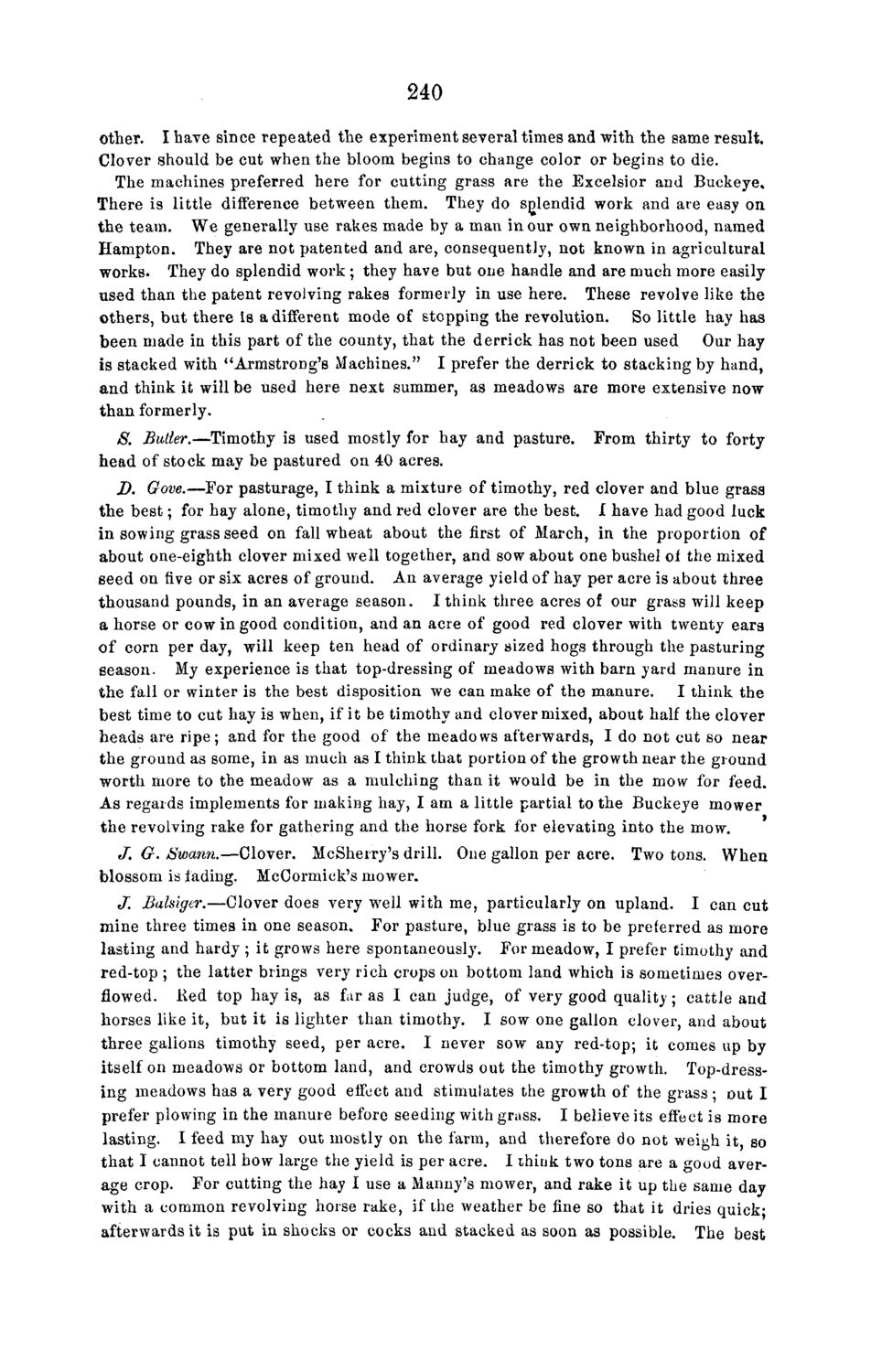| |
| |
Caption: Board of Trustees Minutes - 1868
This is a reduced-resolution page image for fast online browsing.

EXTRACTED TEXT FROM PAGE:
240 other. I have since repeated the experiment several times and with the same result. Clover should be cut when the bloom begins to change color or begins to die. The machines preferred here for cutting grass are the Excelsior and Buckeye, There is little difference between them. They do splendid work and are easy on the team. We generally use rakes made by a man in our own neighborhood, named Hampton. They are not patented and are, consequently, not known in agricultural works. They do splendid work ; they have but one handle and are much more easily used than the patent revolving rakes formerly in use here. These revolve like the others, but there Is a different mode of stopping the revolution. So little hay has been made in this part of the county, that the derrick has not been used Our hay is stacked with "Armstrong's Machines." I prefer the derrick to stacking by hand, and think it will be used here next summer, as meadows are more extensive now than formerly. 8. Butler.—Timothy is used mostly for hay and pasture. From thirty to forty head of stock may be pastured on 40 acres. D. Gove.—For pasturage, I think a mixture of timothy, red clover and blue grass the best; for hay alone, timothy and red clover are the best. I have had good luck in sowing grass seed on fall wheat about the first of March, in the proportion of about one-eighth clover mixed well together, and sow about one bushel of the mixed geed on five or six acres of ground. An average yield of hay per acre is about three thousand pounds, in an average season. I think three acres of our grass will keep a horse or cow in good condition, and an acre of good red clover with twenty ears of corn per day, will keep ten head of ordinary sized hogs through the pasturing season. My experience is that top-dressing of meadows with barn yard manure in the fall or winter is the best disposition we can make of the manure. I think the best time to cut hay is when, if it be timothy and clover mixed, about half the clover heads are ripe; and for the good of the meadows afterwards, I do not cut so near the ground as some, in as much as I think that portion of the growth near the ground worth more to the meadow as a mulching than it would be in the mow for feed. As regards implements for making hay, I am a little partial to the Buckeye mower the revolving rake for gathering and the horse fork for elevating into the mow. J. G. /Swann.—Clover. McSherry's drill. One gallon per acre. Two tons. When blossom is fading. McCormick's mower. J. Bahiger.—Clover does very well with me, particularly on upland. I can cut mine three times in one season. For pasture, blue grass is to be preferred as more lasting and hardy ; it grows here spontaneously. For meadow, I prefer timothy and red-top ; the latter brings very rich crops on bottom land which is sometimes overflowed. Red top hay is, as far as I can judge, of very good quality; cattle and horses like it, but it is lighter than timothy. I sow one gallon clover, and about three gallons timothy seed, per acre. I never sow any red-top; it comes up by itself on meadows or bottom land, and crowds out the timothy growth. Top-dressing meadows has a very good effect and stimulates the growth of the grass; out I prefer plowing in the manure before seeding with grass. I believe its effect is more lasting. I feed my hay out mostly on the farm, and therefore do not weigh it, so that I cannot tell how large the yield is per acre. I thiuk two tons are a good average crop. For cutting the hay I use a Manny's mower, and rake it up the same day with a common revolving horse rake, if the weather be fine so that it dries quickafterwards it is put in shocks or cocks and stacked as soon as possible. The best
| |